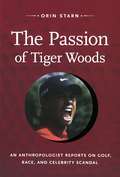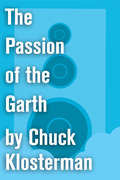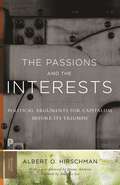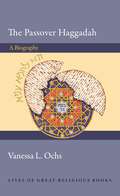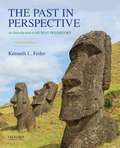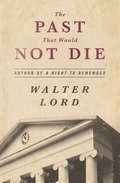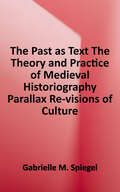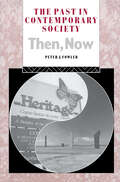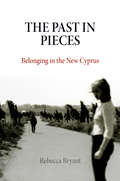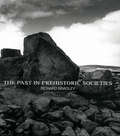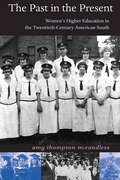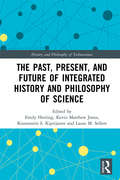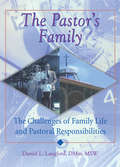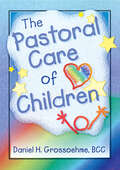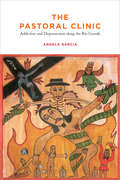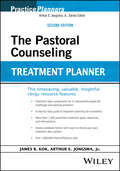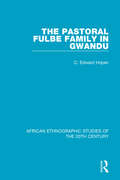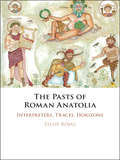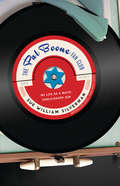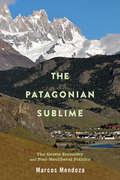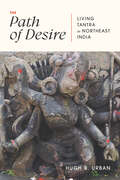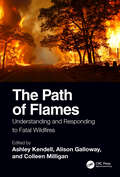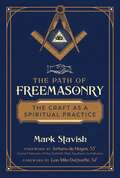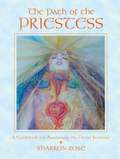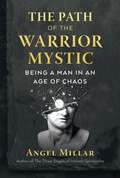- Table View
- List View
The Passion of Tiger Woods: An Anthropologist Reports on Golf, Race, and Celebrity Scandal
by Orin StarnPerhaps the best golfer ever, Tiger Woods rocketed to the top of a once whites-only sport. Endorsements made him a global brand and the world's richest athlete. The child of a multiracial marriage, Woods and his blond, blue-eyed wife, Elin Nordegren, seemed to represent a new postracial America. Then, in late 2009, Woods became embroiled in a sex scandal that made headlines worldwide. In this concise yet far-reaching analysis, Orin Starn brings an anthropologist's perspective to bear on Tigergate. He explores our modern media obsession with celebrity scandals and their tawdry ritualized drama, yet he offers much more than the usual banal moralizing about the rich and famous. Starn explains how Tiger's travails and the culture of golf reflect broader American anxieties--about race and sex, scapegoating and betrayal, and the role of the sports hero. The Passion of Tiger Woods is required reading for all those interested in the high-stakes world of professional golf, the politics of sports and celebrity, and the myths and realities surrounding the flawed yet riveting figure who remains among the most famous athletes of our time.
The Passion of the Garth
by Chuck KlostermanOriginally collected in Eating the Dinosaur and now available both as a stand-alone essay and in the ebook collection Chuck Klosterman on Pop, this essay is about Garth Brooks.
The Passions and the Interests: Political Arguments for Capitalism before Its Triumph (Princeton Classics #2)
by Albert O. HirschmanIn this volume, Albert Hirschman reconstructs the intellectual climate of the seventeenth and eighteenth centuries to illuminate the intricate ideological transformation that occurred, wherein the pursuit of material interests--so long condemned as the deadly sin of avarice--was assigned the role of containing the unruly and destructive passions of man. Hirschman here offers a new interpretation for the rise of capitalism, one that emphasizes the continuities between old and new, in contrast to the assumption of a sharp break that is a common feature of both Marxian and Weberian thinking. Among the insights presented here is the ironical finding that capitalism was originally supposed to accomplish exactly what was soon denounced as its worst feature: the repression of the passions in favor of the "harmless," if one-dimensional, interests of commercial life. To portray this lengthy ideological change as an endogenous process, Hirschman draws on the writings of a large number of thinkers, including Montesquieu, Sir James Steuart, and Adam Smith. Featuring a new afterword by Jeremy Adelman and a foreword by Amartya Sen, this Princeton Classics edition of The Passions and the Interests sheds light on the intricate ideological transformation from which capitalism emerged triumphant, and reaffirms Hirschman's stature as one of our most influential and provocative thinkers.Some images inside the book are unavailable due to digital copyright restrictions.
The Passover Haggadah: A Biography (Lives of Great Religious Books #51)
by Vanessa L. OchsThe life and times of a treasured book read by generations of Jewish families at the seder tableEvery year at Passover, Jews around the world gather for the seder, a festive meal where family and friends come together to sing, pray, and enjoy traditional food while retelling the biblical story of the Exodus. The Passover Haggadah provides the script for the meal and is a religious text unlike any other. It is the only sacred book available in so many varieties—from the Maxwell House edition of the 1930s to the countercultural Freedom Seder—and it is the rare liturgical work that allows people with limited knowledge to conduct a complex religious service. The Haggadah is also the only religious book given away for free at grocery stores as a promotion. Vanessa Ochs tells the story of this beloved book, from its emergence in antiquity as an oral practice to its vibrant proliferation today.Ochs provides a lively and incisive account of how the foundational Jewish narrative of liberation is remembered in the Haggadah. She discusses the book's origins in biblical and rabbinical literature, its flourishing in illuminated manuscripts in the medieval period, and its mass production with the advent of the printing press. She looks at Haggadot created on the kibbutz, those reflecting the Holocaust, feminist and LGBTQ-themed Haggadot, and even one featuring a popular television show, The Marvelous Mrs. Maisel. Ochs shows how this enduring work of liturgy that once served to transmit Jewish identity in Jewish settings continues to be reinterpreted and reimagined to share the message of freedom for all.
The Past In Perspective: An Introduction To Human Prehistory (Seventh Edition)
by Kenneth L. FederIdeal for introduction to archaeology and world prehistory courses, The Past in Perspective: An Introduction to Human Prehistory, Seventh Edition, is an engaging and up-to-date chronological overview of human prehistory. <P><P>Kenneth L. Feder introduces students to "the big picture"--the grand sweep of human evolutionary history--presenting the human past within the context of fundamental themes of cultural evolution. Feder's unique, refreshing, and accessible narrative personalizes the past and makes it relevant to today's students. <P><P>Using a consistent chapter format--"Prelude, Chronicle, Issues and Debates, Messages from the Past, and Case Study Close-up"--Feder helps students master both what we know and what is still debated about the complex story of the human past.
The Past That Would Not Die
by Walter LordLord&’s history of the 1962 Ole Miss riots, sparked by one man&’s heroic stance against segregation in the American South On September 30, 1962, James H. Meredith matriculated at the University of Mississippi in Oxford. An air force veteran with sixty hours of transfer credits, Meredith would have been welcomed were it not for the color of his skin. As the first African-American student to register at a previously segregated school, however, he risked his life. The Supreme Court had determined that Oxford&’s university must desegregate, and several hundred federal marshals came to support Meredith. It would not be enough. As President Kennedy called for peace, a riot exploded in Oxford. By eleven o&’clock that night, the marshals were out of tear gas. By midnight, the highway patrol had pulled out, gunfire was spreading, and Kennedy was forced to send in the army. In this definitive history, Walter Lord argues that the riot was not an isolated incident, but a manifestation of racial hatred that was wrapped up in the state&’s identity, stretching all the way back to the Civil War.
The Past as Text: The Theory and Practice of Medieval Historiography
by Gabrielle M. SpiegelThis study of familiar medieval histories and chronicles argues that the historian should be aware of the discursive nature, literary modes, and ideological investments of such texts as well as the social circumstances to which they were applied and by which they were generated. Postmodernism has challenged historians to look at historical texts in a new way and to be skeptical of the claim that one can confidently retrieve "fact" from historical writings. In The Past as Text historian Gabrielle M. Spiegel sets out to read medieval histories and chronicles in light of the critical-theoretical problems raised by postmodernism. At the same time, she urges a method of analysis that enables the reader to recognize these texts simultaneously as artifice and as works deeply embedded in a historically determinate, knowable social world. Beginning with a theoretical basis for the study of medieval historiography, Spiegel demonstrates her theory in practice, offering readings of medieval histories and chronicles as literary, social, and political constructions. The study insightfully concludes that historians should be equally aware of the discursive nature, literary modes, and ideological investments of such texts and the social circumstances to which they were applied and by which they were generated. Arguing for the "social logic of the text," Spiegel provides historians with a way to retrieve the social significance and conceptual claims produced by these medieval or any historical writings.
The Past in Contemporary Society: Then, Now (Heritage: Care-Preservation-Management)
by Peter FowlerFirst published in 2002. Routledge is an imprint of Taylor & Francis, an informa company.
The Past in Pieces: Belonging in the New Cyprus (Contemporary Ethnography)
by Rebecca BryantOn April 23, 2003, to the surprise of much of the world, the ceasefire line that divides Cyprus opened. The line had partitioned the island since 1974, and so international media heralded the opening of the checkpoints as a historic event that echoed the fall of the Berlin Wall. As in the moment of the Wall's collapse, cameras captured the rush of Cypriots across the border to visit homes unwillingly abandoned three decades earlier. It was a euphoric moment, and one that led to expectations of reunification. But within a year Greek Cypriots overwhelmingly rejected at referendum a United Nations plan to reunite the island, despite their Turkish compatriots' support for the plan. In The Past in Pieces, anthropologist Rebecca Bryant explores why the momentous event of the opening has not led Cyprus any closer to reunification, and indeed in many ways has driven the two communities of the island further apart.This chronicle of the "new Cyprus" tells the story of the opening through the voices and lives of the people of one town that has experienced conflict. Over the course of two years, Bryant studied a formerly mixed town in northern Cyprus in order to understand both experiences of life together before conflict and the ways in which the dissolution of that shared life is remembered today. Tales of violation and loss return from the past to shape meanings of the opening in daily life, redefining the ways in which Cypriots describe their own senses of belonging and expectations of the political future. By examining the ways the past is rewritten in the present, Bryant shows how even a momentous opening may lead not to reconciliation but instead to the discovery of new borders that may, in fact, be the real ones.
The Past in Prehistoric Societies
by Richard BradleyThe idea of prehistory dates from the nineteenth century, but Richard Bradley contends that it is still a vital area for research. He argues that it is only through a combination of oral tradition and the experience of encountering ancient material culture that people were able to formulate a sense of their own pasts without written records.The Past in Prehistoric Societies presents case studies which extend from the Palaeolithic to the early Middle Ages and from the Alps to Scandinavia. It examines how archaeologists might study the origin of myths and the different ways in which prehistoric people would have inherited artefacts from the past. It also investigates the ways in which ancient remains might have been invested with new meanings long after their original significance had been forgotten. Finally, the author compares the procedures of excavation and field survey in the light of these examples.The work includes a large number of detailed case studies, is fully illustrated and has been written in an extremely accessible style.
The Past in the Present: Women's Higher Education in the Twentieth-century American South
by Amy T. McCandlessThe history of higher education in the 20th-century South, like the history of the region, both mirrors and diverges from the national pattern. Not surprisingly the region’s demographic, economic, social, political, and cultural characteristics have accounted for many of the variations between the education of southern women and women in the rest of the nation.
The Past, Present, and Future of Integrated History and Philosophy of Science (History and Philosophy of Technoscience)
by Emily Herring Kevin Matthew Jones Konstantin S. Kiprijanov Laura M SellersIntegrated History and Philosophy of Science (iHPS) is commonly understood as the study of science from a combined historical and philosophical perspective. Yet, since its gradual formation as a research field, the question of how to suitably integrate both perspectives remains open. This volume presents cutting edge research from junior iHPS scholars, and in doing so provides a snapshot of current developments within the field, explores the connection between iHPS and other academic disciplines, and demonstrates some of the topics that are attracting the attention of scholars who will help define the future of iHPS.
The Pastor's Family: The Challenges of Family Life and Pastoral Responsibilities
by Harold G Koenig Daniel L LangfordDescribing the difficulties of balancing a career and family life, The Pastor’s Family: The Challenges of Family Life and Pastoral Responsibilities is a personal narrative that discusses the all-too-familiar practice of neglecting your family for your job. Pastors will learn the importance of balancing time and attention between their families and religious careers by exploring the problems caused by one pastor’s prolonged absence from home. Containing research and first-hand experiences, The Pastor’s Family calls for a change in ministry policies that will enable pastors to devote as much time to their families as they do to their congregations.Containing stories and anecdotes from the author, his wife, and his two children, this book offers suggestions on how to improve the physical, emotional, and spiritual health of a pastor’s family. The information and insight provided by The Pastor’s Family will also help pastors’wives realize that they are not alone in their demanding roles and will help church policymakers discover the need to improve relations between the congregation and the pastor’s family. With the hope that the universal problems of pastors’families will be revealed, the author shares with you methods that have helped bring him and his family closer together, including: understanding the expectations of the stereotypical “superpastor” and learning how to set boundaries between family life and career realizing that a pastor’s family is subject to the same problems and challenges other families face and helping your family deal with this pressure learning the various definitions of codependency and how this can attribute to the neglect of your family discussing the history of abuse of pastors’families through the Bible and famous religious figures recognizing the discrimination of a pastor’s wife and her sufferings, such as coping with her husband’s various psychological challenges and being expected to always help her husband with his career discovering how conflicts can provoke communication, release emotions, identify and clarify problems, and permit individualization understanding why people feel a loss of power or personal rejection when their requests are not grantedEmphasizing the practice of setting boundaries, The Pastor’s Family examines ways to promote assertiveness through self-talk and self-differentiation that will help you defeat codependent behavior. This will teach you that it is all right to say “no”-- that it is all right to do things for yourself. From The Pastor’s Family, you will learn how to correct the ideology that makes many pastors feel they must honor every parishioner request, despite the effect it will have on his family. Through stories of hardship and personal revelations, this book will help you realize the need for church policy reforms that will allow pastors to be looked upon as humans who have familiesbesides their parishioners.
The Pastoral Care of Children
by Harold KoenigExplore a new way of pastoral care that enables caregivers to develop relationships and provide meaningful pastoral care to the children and youth they encounter! The Pastoral Care of Children focuses on the need for pastoral caregivers, clergy and chaplains to develop relationships with youths and gives you suggestions to overcome the anxiety associated with caring for an acutely ill child through unique, playful, and child-centered approaches. Many pastoral caregivers have high anxiety when children are ill or hurt, are unsure how to have a substantive conversation with a nine-year old, or their fears of what could be said keep them from hearing what children have to say. The effective approaches in The Pastoral Care of Children are illustrated to assist you with serving the spiritual needs of children. You will explore actual pastoral care experiences that will help you gain confidence in handling situations such as a teenager’s desire to be baptized out of fear of death when neither he nor his parents believe in Christ. Intelligent and heartfelt, this valuable book gives you a complete theological exploration of ministering to children who may ask you “Why me?”, “Why do people have to die?” and “What happens to children if they die before they are baptized?” The Pastoral Care of Children helps you answer these questions with meaningful responses that are genuine and grounded with yourself, and reflect the parents’beliefs. Some of the help you will discover in The Pastoral Care of Children includes: understanding the similarities and differences of caring for children in comparison to adults, such as different vocabularies but similar emotions, and realizing that children are very perceptive using play as a tool, for example referring to a puppet’s experience in reference to the child to eliminate the child’s self-consciousness and help him or her open up confronting pastoral issues in acute care settings, such as fear, guilty feelings, and anger, from parents, family and the child helping children recover from mental health issues such as depression, eating disorders, and identity and self-esteem issues by using cognitive therapy conducting prayer and rituals with children such as baptism, naming ceremonies, anointings, and funerals to assist the child and family through this spiritual rite of passage Complete with child and family focused approaches for dealing with the questions surrounding death, The Pastoral Care of Children also provides you with several cited scriptures, and a list of questions you may be asked by a child who is facing death. You will learn from actual circumstances pastoral caregivers have encountered and discover how to approach topics, and answer questions on God and death. The Pastoral Care of Children, an extremely resourceful book that will assist you in overcoming anxiety and help you deliver thoughtful and uplifting pastoral care to children and youth.
The Pastoral Clinic
by Angela GarciaThe Pastoral Clinic takes us on a penetrating journey into an iconic Western landscape--northern New Mexico's Española Valley, home to the highest rate of heroin addiction and fatal overdoses in the United States. In a luminous narrative, Angela Garcia chronicles the lives of several Hispano addicts, introducing us to the intimate, physical, and institutional dependencies in which they are entangled. We discover how history pervades this region that has endured centuries of material and cultural dispossession, and we come to see its heroin problem as a contemporary expression of these conditions, as well as a manifestation of the human desire to be released from them. Lyrically evoking the Española Valley and its residents through conversations, encounters, and recollections, The Pastoral Clinic is at once a devastating portrait of addiction, a rich ethnography of place, and an eloquent call for a new ethics of care.
The Pastoral Counseling Treatment Planner (PracticePlanners)
by Arthur E. Jongsma Jr. James R. KokOver 1,300 well-crafted treatment goals, objectives and interventions for many of life’s thorniest problems For pastoral counselors and clergy people seeking effective therapeutic techniques, The Pastoral Counseling Treatment Planner is a lifesaver. And for secular therapists integrating elements of their clients’ spirituality into treatment process, this book can guide the way. Patterned after the bestselling The Adult Psychotherapy Treatment Planner, this resource draws on a variety of Western religious belief systems and offers step-by-step guidelines on counseling clients and parishioners through life’s dilemmas. This sourcebook is organized around 31 common problems, including marital conflict, grief, chronic illness, and challenges of faith. For each problem, behavioral definitions and potential counseling goals are provided, along with dozens of suggested interventions—many of which draw upon the client’s faith as a source of healing. This is a hands-on resource that you can use directly in your counseling. The pages afford plenty of space to record customized counseling goals, objectives, and interventions for your parishioners. A faith-forward entry in the trusted Treatment Planner series, The Pastoral Counseling Treatment Planner simplifies the planning process, so you can focus on helping those who need you. Access a sample counseling plan appropriate for both experienced counselors and novices Quickly develop individualized plans by selecting from over 1,300 descriptive statements. Addresses emotional problems as well as life stage issues, family conflicts, marital issues, and challenges to faith A resource for religious leaders who provide counseling to parishioners and secular counselors who incorporate spirituality into their practice. A resource for religious leaders who provide counseling to parishioners and secular counselors who incorporate spirituality in their practice make this sentence the final bullet point! For more information on our Wiley PracticePlanners®, including our full line of Treatment Planners, visit us on the Web at:www.wiley.com/practiceplanners
The Pastoral Fulbe Family in Gwandu
by C. Edward HopenOriginally published in 1958, this book discusses how marriage and Fulbe family life, the economy and the whole organization of society is centred on cattle; how the welfare of the herd and its increase, the balance betweent he size of the herd and the size of the family are major preoccupations in the life of a Fulani herd-owner.
The Pasts of Roman Anatolia: Interpreters, Traces, Horizons
by Felipe RojasIn this volume, Felipe Rojas examines how the inhabitants of Roman Anatolia interacted with the physical traces of earlier civilizations in their midst. Combining material and textual evidence, he shows that interest in and knowledge about pre-classical remains was deep and widespread. Indeed, ancient interaction with the remnants of even more ancient pasts was a vital part of life for many and diverse people in Roman Anatolia. Such interaction ranged from the purported translation of Bronze and Iron Age inscriptions to the physical manipulation of monuments and objects, including prehistoric earthen mounds and archaic statues. Occasionally, it even involved the production of fake antiquities. Offering new insights into both the archaeology and history of the Roman Mediterranean, Rojas's book is also an innovative contribution to the archaeology and anthropology of memory.
The Pat Boone Fan Club: My Life as a White Anglo-Saxon Jew (American Lives)
by Sue William SilvermanGentile reader, and you, Jews, come too. Follow Sue William Silverman, a one-woman cultural mash-up, on her exploration of identity among the mishmash of American idols and ideals that confuse most of us—or should. Pat Boone is our first stop. Now a Tea Party darling, Boone once shone as a squeaky-clean pop music icon of normality, an antidote for Silverman’s own confusing and dangerous home, where being a Jew in a Christian school wasn’t easy, and being the daughter of the Anti-Boone was unspeakable. And yet somehow Silverman found her way, a “gefilte fish swimming upstream,” and found her voice, which in this searching, bracing, hilarious, and moving book tries to make sense of that most troubling American condition: belonging, but to what?Picking apricots on a kibbutz, tramping cross-country in a loathed Volkswagen camper, appearing in a made-for-television version of her own life: Silverman is a bobby-soxer, a baby boomer, a hippy, a lefty, and a rebel with something to say to those of us—most of us—still wondering what to make of ourselves.
The Patagonian Sublime: The Green Economy and Post-Neoliberal Politics
by Marcos MendozaThe Patagonian Sublime provides a vivid, accessible, and cutting-edge investigation of the green economy and New Left politics in Argentina. Based on extensive field research in Glaciers National Park and the mountain village of El Chaltén, Marcos Mendoza deftly examines the diverse social worlds of alpine mountaineers, adventure trekkers, tourism entrepreneurs, seasonal laborers, park rangers, land managers, scientists, and others involved in the green economy. Mendoza explores the fraught intersection of the green economy with the New Left politics of the Néstor Kirchner and Cristina Fernández de Kirchner governments. Mendoza documents the strategies of capitalist development, national representation, and political rule embedded in the “green productivist” agenda pursued by Kirchner and Fernández. Mendoza shows how Andean Patagonian communities have responded to the challenges of community-based conservation, the fashioning of wilderness zones, and the drive to create place-based monopolies that allow ecotourism destinations to compete in the global consumer economy.
The Path of Desire: Living Tantra in Northeast India
by Hugh B. UrbanA provocative study of contemporary Tantra as a dynamic living tradition. Tantra, one of the most important religious currents in South Asia, is often misrepresented as little more than ritualized sex. Through a mixture of ethnography and history, Hugh B. Urban reveals a dynamic living tradition behind the sensationalist stories. Urban shows that Tantric desire goes beyond the erotic, encompassing such quotidian experiences as childbearing and healing. He traces these holistic desires through a series of unique practices: institutional Tantra centered on gurus and esoteric rituals; public Tantra marked by performance and festival; folk Tantra focused on magic and personal well-being; and popular Tantra imagined in fiction, film, and digital media. The result is a provocative new description of Hindu Tantra that challenges us to approach religion as something always entwined with politics and culture, thoroughly entangled with ordinary needs and desires.
The Path of Flames: Understanding and Responding to Fatal Wildfires
by Alison Galloway Ashley Kendell Colleen MilliganThe Path of Flames: Understanding and Responding to Fatal Wildfires is an edited volume covering the complexities of response and recovery issues relative to catastrophic wildfires. As wildfires become more frequent throughout the world—and the loss of life greater, especially among residents trapped in the path of the flames—it is essential that agencies in fire-prone areas understand the complexity of the response as it relates to finding and identifying the remains of those who perished. While covering wildfire dynamics, risks for vulnerable populations, and the emergency response to wildfires, this book focuses largely on the recovery of human remains within the context of the overall response to mass disasters resulting from wildfires. As such, search protocols, staffing needs, pre-event coordination and organization, and logistical support are addressed. The scientific basis for understanding how fire will affect human remains—as well as how the level of destruction can be interpreted—is also addressed. Recognizing the multidisciplinary nature of the field, this volume covers forensic issues relating to the recovery of remains, forensic anthropology, DNA analysis, forensic odontology, and forensic pathology. The book also includes contributions from international wildfire response professionals looking at global best practices in wildfire response and human remains recovery. Specifically, several chapters cover the lessons learned from the devasting Camp Fire of 2018 in California that led to the deaths of 85 people. The Camp Fire burned nearly 19,000 structures and was ultimately the most destructive—and deadly—in California’s history. The Path of Flames is a one-of-a-kind reference that serves as a valuable resource for professionals working in the areas of emergency services, search and rescue, law enforcement, fire service, disaster planning and response, victim recovery and identification, and mass disaster and mass fatality response.
The Path of Freemasonry: The Craft as a Spiritual Practice
by Mark Stavish• Shares the history and meaning of Freemasonry and its symbols • Offers thoughtful explorations of different areas of Masonic experience, drawing on esoteric doctrines and paralleling them with experiences found in daily life • Provides simple exercises and practices to help internalize and personalize the lessons presented, including dreamwork, journaling, meditation, and prayer In this practical guide, Mark Stavish details the spiritual lessons and rituals of Freemasonry as a step-by-step path of spiritual development and self-improvement for both Masons and non-Masons, men and women, alike. He explores the history and meaning of Freemasonry and its symbols--from its origins in the Temple of Solomon to the Medieval craft guilds to the Renaissance--and explains how the Craft promotes personal growth through the symbolic building of self and an inner Temple of Wisdom in much the same way that Masonry&’s rituals symbolize the building of Solomon&’s Temple in accordance with the mystical architectural instructions of Hiram. Drawing on esoteric doctrines, including the Qabala, alchemy, sacred geometry, John Dee&’s angelic magic, and the secrets of the Gothic cathedral builders, each chapter addresses an area of the Masonic experience, paralleling them with experiences each of us finds in our own lives. The author provides simple practices to help internalize and personalize the lessons presented, including dreamwork, journaling, meditation, prayer, and understanding sacred architecture. The author also examines the crafting and use of the spiritual and symbolic tools of Freemasonry, such as the trestle or tracing board and the Chamber of Reflection. Providing the tools to make the Craft an initiatic experience of self-improvement, the author shows that, ultimately, the Masonic experience is the human quest for self-realization and self-expression, so that we each may find our place in the Temple of Wisdom.
The Path of the Priestess: A Guidebook for Awakening the Divine Feminine
by Sharron RoseA guide for personal exploration of the path to the divine feminine and the spiritual power of women.• Reveals the essential role of women in creating and maintaining the psychic/energetic/emotional landscape of society.• Explores feminine roles and the archetypal model of the Great Goddess from both Eastern and Western spiritual traditions.• Includes exercises, meditations, and visualizations drawn from ancient techniques to assist women with their spiritual awakening and self-realization.The Path of the Priestess takes readers on a journey deep into the heart of the feminine experience. It describes the author's years of first-hand experience in the ancient arts of Tantra, Dzogchen, and Indian and Egyptian temple dance and healing, as well as her research into the feminine principle in the mystic teachings of the Alchemists, Hebrew Kabbalists, and Christian Gnostics. Beginning with an analysis of the basic issues and frustrations inherent in contemporary society's conditioning of and expectations for women, readers travel back in time to the age of the great temples, schools, and sacred societies in which women still held and transmitted the spiritual light that nourished all of civilization. Through its mythic and historic tales, descriptions of sacred ritual practices, and teachings on the Goddess traditions, The Path of the Priestess provides contemporary women with the means to enter this time-honored path. In keeping with the experientially based teaching methods of these traditions, it also offers exercises and visualizations designed to align women with the powerful, sensuous, and loving energies of the most profound feminine role model that shaped and preserved culture and society--the Great Goddess.
The Path of the Warrior-Mystic: Being a Man in an Age of Chaos
by Angel Millar• Explores the archetypal and classical male ideal found in ancient societies around the world • Examines some of the problems facing men in the world today and shares practices to develop yourself in the face of these problems • Provides techniques for developing your thinking and focus, overcoming fear, relaxing tension in your body, and developing a self-image more appropriate to who you are and aspire to be Ancient and classical societies have always had an ideal of manhood. In Japan, the samurai cultivated not only the art of the sword but also poetry, calligraphy, and spiritual practice. In Confucianism, the ideal man was the Chun-Tzu (the Higher Man), who cultivated both the arts of war and the arts of peace. And in medieval Europe, the knight lived by the comparable code of chivalry. Such men, considered both warriors and mystics, exempli ed wholeness. Yet today, men exist in a chaotic world without role models, guidance, or a sense of the sacred masculine.Exploring how to reconnect with the archetypal male ideal and develop the different sides of your being, author Angel Millar offers a journey of self-development to help cultivate yourself as a whole--mentally, physically, and spiritually. He examines some of the problems facing men in the world today--lack of strong friendships, distractingtechnology, constant criticism--and shares practices to develop yourself in the face of these problems. He shares techniques for enhancing your focus, overcoming fear, integrating your shadow, developing inner silence, and creating a self-image more appropriate to who you are and who you aspire to be. He also explores the importance of relaxing tension in your body to help you break free from pattern-induced behavior and self-defeating thoughts embedded through muscle memory.Examining in uential gures both contemporary and historical like Steve Jobs and Swami Vivekananda, powerful myths from East and West such as the tale of Sir Gawain and the Green Knight, warrior and brotherhood traditions as well as literature and fine art, this guide will help you discover your inner sacred masculine, a better understanding of the world and your place in it, and ultimately how to become a confident, strong, and dynamic contemporary higher man and a leader in your own life.
